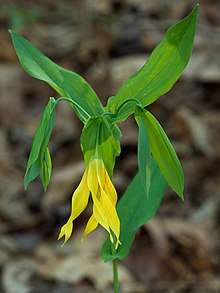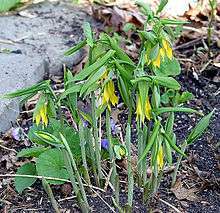Uvularia grandiflora
Uvularia grandiflora, the large-flowered bellwort or merrybells, is a species of flowering plant in the family Colchicaceae, native to eastern and central North America.[1]
| Uvularia grandiflora | |
|---|---|
 | |
| Scientific classification | |
| Kingdom: | Plantae |
| Clade: | Tracheophytes |
| Clade: | Angiosperms |
| Clade: | Monocots |
| Order: | Liliales |
| Family: | Colchicaceae |
| Genus: | Uvularia |
| Species: | U. grandiflora |
| Binomial name | |
| Uvularia grandiflora | |
Description

Growing to 75 cm (30 in) tall by 30 cm (12 in) broad, it is a rhizomatous herbaceous perennial with pendent leaves which are hairy on the undersides. It blooms in mid- to late spring, producing large yellow, solitary or paired, bell-shaped, pendent flowers.[2] The top parts of the plant tend to bend downward due to the weight of the leaves and flowers. The light green stems are round, glabrous, and glaucous and the leaves are perfoliate since the stem appears to come through the leaves at the base. In late summer three capsuled ovaries split open releasing seeds that have attached food bodies called (elaiosome) which are attractive to ants that collect and redistribution the seeds.[3]
The Latin specific epithet grandiflora means "large flowered".[4]
This plant differs from Uvularia sessilifolia in that the leaves of the latter grow from the stem and its flowers are smaller. U. grandiflora also differs from Uvularia perfoliata, which occurs in eastern North America. The latter has similar large perfoliate leaves, but the flowers have orange-colored bumps on the petals.
Range
The native range of Uvularia grandiflora extends from the Appalachians west to the Dakotas, Kansas and Oklahoma, from Louisiana and Georgia in the South to Manitoba, Ontario and Quebec in Canada. So, it is widespread across the eastern mountains, the Great Lakes and the Mississippi Valley. There are also isolated populations along Chesapeake Bay in Maryland.[5]
Ecology
Uvularia grandiflora is a woodland species found in open shade in rich moist woods with calcareous to neutral soils.[6]
Bumblebees, mason bees, halictid bees, and andrenid bees feed from the nectar and collect pollen from the flowers. Deer love to eat these plants.[7]
Conservation status in the United States
The plant is listed as endangered in New Hampshire[5] and Connecticut.[8]
Ethnobotany
The Menominee use this plant for swellings.[9] The Ojibwa are documented to use the root for pain in the solar plexus, which may refer to pleurisy.[10] The Potawatomi mix an infusion of the root mixed with lard and use it as salve to massage sore muscles and tendons.[11]
Cultivation
In cultivation in the UK Uvularia grandiflora has gained the Royal Horticultural Society's Award of Garden Merit.[12][13] There exists a cultivar 'Pallida' with paler coloured flowers.[14]
References
- "Uvularia grandiflora". Natural Resources Conservation Service PLANTS Database. USDA. Retrieved 22 September 2018.
- RHS A-Z encyclopedia of garden plants. United Kingdom: Dorling Kindersley. 2008. p. 1136. ISBN 1405332964.
- Timothy P. Spira (16 May 2011). Wildflowers and Plant Communities of the Southern Appalachian Mountains and Piedmont: A Naturalist's Guide to the Carolinas, Virginia, Tennessee, and Georgia. Univ of North Carolina Press. pp. 462–. ISBN 978-0-8078-7765-4.
- Harrison, Lorraine (2012). RHS Latin for Gardeners. United Kingdom: Mitchell Beazley. ISBN 184533731X.
- "Uvularia grandiflora". Natural Resources Conservation Service PLANTS Database. USDA. Retrieved 19 December 2017.
- Utech, Frederick H.; Kawano, Shoichi (2002). "Uvularia grandiflora". In Flora of North America Editorial Committee (ed.). Flora of North America North of Mexico (FNA). 26. New York and Oxford – via eFloras.org, Missouri Botanical Garden, St. Louis, MO & Harvard University Herbaria, Cambridge, MA.
- Charlotte Adelman; Bernard L. Schwartz (21 September 2011). The Midwestern Native Garden: Native Alternatives to Nonnative Flowers and Plants. Ohio University Press. pp. 77–. ISBN 978-0-8214-4356-9.
- "Connecticut's Endangered, Threatened and Special Concern Species 2015" (PDF). State of Connecticut Department of Energy and Environmental Protection Bureau of Natural Resources. Retrieved 1 January 2018. (Note: This list is newer and updated from the one used by plants.usda.gov)
- Smith, Huron H. (1923). "Ethnobotany of the Menomini Indians". Bulletin of the Public Museum of the City of Milwaukee. 4: 41.
- Smith, Huron H. (1932). "Ethnobotany of the Ojibwe Indians". Bulletin of the Public Museum of Milwaukee. 4: 374.
- Smith, Huron H. (1933). "Ethnobotany of the Forest Potawatomi Indians". Bulletin of the Public Museum of the City of Milwaukee. 7: 56, 57, 64.
- "RHS Plant Selector - Uvularia grandiflora". Retrieved 15 April 2020.
- "AGM Plants - Ornamental" (PDF). Royal Horticultural Society. July 2017. p. 106. Retrieved 10 January 2010.
- Bourne, Val. "Merrybells". Daily Telegraph. Retrieved 4 May 2013.
External links
| Wikimedia Commons has media related to Uvularia grandiflora. |